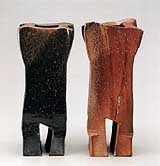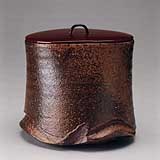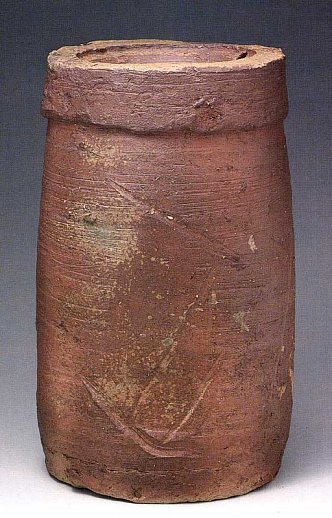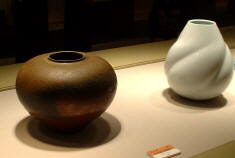|
YEARLY ROUNDUP 2004
 |
We Japanese find ourselves huddling together with family during the New Year, bracing ourselves from the cold within our wooden homes, as the wind keeps pouring through the cracks, leaving our limbs numb, but our hearts warm.
Of course, many in the city live in concrete apartments. The winds are still cold, and the hearts, still warm.
We also drink ourselves to a pulp during this season. I, for one, had far too many bottles of beer and sake (surely not one of the more harmonious pairings of alcoholic beverages) during the December Bonenkai parties, or the "Let's Forget About What Happened This Year" celebrations. In other words, we drown ourselves in drink to aggressively induce memory loss. This works quite well.
But when the New Year comes around, a soothing, relaxed air enwraps the archipelago. Kimonos are plucked from drawers, dusted off and worn for a change. Osechi, or a traditional assortment of lucky morsels such as fishcakes, black beans, and sweetened chestnuts, are consumed across the nation. Otoshidama, or a small allowance, is handed to children (and they turn to monkeys over the yen, but I don't blame them, as we adults are far crazier). And we go to pray at shrines and temples, the first prayer of the year called Hatsumoude.
To bring peace, happiness and prosperity to ourselves and to our loved ones.
To Japan, and to the world.
And as I slowly awakened from the snowy slumber of holidays well spent, I sobered to the stark reality that a hefty sum of work awaited me back in the office. What's more, the first job to greet me was the interview with Kaneko Kenji, Chief Curator of the National Museum of Modern Art, Tokyo. MOMAT is the common acronym, but I prefer MOMA Tokyo, as MOMAT sounds like some Polynesian fruit.
I've read many of Kaneko's publications, interviews and articles, with the skin on my forehead creasing in several layers, especially between the eyes. His writing is, without doubt, difficult. For example, Kaneko calls one of his prime ceramic concepts 工芸的造形, or "craftical formation." I had no idea what that meant, until I asked him myself.
Euphemism and doubletalk exist in Japanese just like they do in English. One of my favorite contemporary Japanese novelists, Machida Koh, purposely showers his sentences with an amalgamation of incomprehensible phrases, using euphemisms as literary weapons. This is not to confuse the reader, but to wrap his language in funny faux intelligence, blended with light-hearted pop gibberish. (Unfortunately, none of Machida's novels have been translated into English. I assume it is because his alien J-pop attitude might be absurdly confusing to a Western audience, but I see that as more a reason to attempt a translation. Offers, anyone?)
Kaneko's use of language is no literary ploy (if it was, I would be laughing with him). Rather, his verbose and tepid language calls to mind what George Orwell wrote in his essay Politics and the English Language:
The great enemy of clear language is insincerity. When there is a gap between one's real and one's declared aims, one turns as it were instinctively to long words and exhausted idioms, like a cuttlefish squirting out ink. Political language -- and with variations this is true of all political parties, from Conservatives to Anarchists -- is designed to make lies sound truthful and murder respectable, and to give an appearance of solidity to pure wind.
Let's just say Mr. Orwell's passage vividly captures my own sentiments regarding Mr. Kaneko's contributions to yakimono theory. I will leave my criticisms of Mr. Kaneko to another article, as the start of a New Year finds no place for negativity. We already have enough of it in the world as I write. And surely, his time will come.
So, the main purpose of the first article of 2005 will be to look back at the ceramic world of 2004, and to review what took place.
For long-time fans of Japanese pottery who still get that tingling sensation when they hear the phrase Living National Treasure, 2004 was a real treat. The 31st LNT, or what is legally known as the Important Intangible Cultural Property (IICP) holder, was bestowed on Bizen's Isezaki Jun, beating out a number of worthy candidates, namely Bizen's Mori Togaku and Mino's Kato Kozo.
As I wrote in a previous article, the "treasure" is not the man, but the traditional techniques he possesses. LNT is a colloquial name, but many perceive it to be an official one. In ceramics, only men have received IICP status. Only potters exhibiting works through the Dento Kogeiten, or the Japanese Traditional Crafts Exhibition, can be lucky candidates; potters that eschew groups, like Tsujimura Shiro or Koie Ryoji, are forever excluded, as well as Nitten-associated potters, like Fukami Sueharu or Fujihira Shin. Odd, isn't it?
And although the original legal statute was made to designate certain individuals with the task of protecting and passing on traditional technique, many often confuse it as a title or award for past achievements or quality of work. It is neither.
|
Bizen Ceramic Works
by Isezaki Jun
|
|

|
|
Rectangular flower vases
|
|

|
|
Straight-rim water jar
|
|
Isezaki is now the 5th LNT from Bizen. The 4th Bizen LNT, Fujiwara Yu, passed away in 2001, leaving a vacancy in the Bizen throne. Such is one reason for Isezaki's "ascendancy." Mino's Kato Kozo was unfortunately born of the same generation as current Shino LNT Suzuki Osamu (not to be confused with the Sodeisha member of the same name), and as long as Suzuki remains perky, Kato's time might never come, although Mashiko and Bizen did previously have simultaneous LNTs. Furthermore, Suzuki's designation was for the technique of Shino alone, and not something as expansive as "Mino." We very well may see Kato being recognized, then, for his technique in Setoguro in the near future.
Quite honestly, I have more qualms with the present system then with the selection of Isezaki. Isezaki is a wonderful potter, who has done much for Bizen. He revived Bizen's ancient anagama underground kilns, was one of the pioneers of the sculptural form in Bizen, and is one of the best teachers around, with apprentices like Shibaoka Koichi, Yamashita Joji, Wakimoto Hiroyuki and Kakurezaki Ryuichi (really, the Isezaki Jun clan has an enormous stable of potters, with a list too long for this article). Even though many might not want to admit it, I personally think the presence of Kakurezaki lingered in the subconscious of the selection committee when they chose Jun as an LNT. What, an apprentice influencing the selection of his master? With Kakurezaki, I find it quite convincing.
But then again, why not Mori Togaku? He revived the gigantic Momoyama o-gama kilns of Bizen, also made sculptural forms (as well as just marvelous works, with both clay flavor and glazing that are distinctively his), and has taught many good potters, namely Suehiro Manabu and Watanabe Satoru. Yet in sheer number of renowned apprentices, Togaku falls short of Jun; furthermore, Togaku has no Kakurezaki to speak of. That said, I enjoy Togaku's works more than I do Jun's.
Jun has great work, for sure. But if you pair 100 random pieces of Jun's with 100 random pieces with Togaku's, I think you will be able to see a difference in the quality of work. Togaku's work always contains a noble element. You can see it in his forms, you can see it in his clay flavor, and you can see it in his firings, especially. in his goma (sesame ash). In other words, I think Togaku has produced a more consistently high-level body of work throughout the years. That said, in no way am I saying that Jun does not have good work. He has exceptional work. But he also has more mediocre work -- works that have neither spirit nor character. Of course, Jun produces a lot more work than Togaku, and if such is the case, the propensity of mediocrity will often increase. And as an aside, Jun is deft at politics. Togaku is hardly as nimble.

Tabimakura by Mori Togaku
Fujihira Shin, a Kyoto potter of the highest order, had a flurry of retrospectives and exhibitions in 2004, perhaps foru or five in all. Granted, he is old (83 and running), but his heart is very young. And in his work lies a fountain of childhood memories, all pouring with the youthful vigor and passion for life. I personally enjoy Fujihira's ceramic boxes, vases, and deep dishes (all superbly crafted, glazed, and fired with an unparalleled imagination) rather than his highly popular ceramic dolls. That said, Fujihira's retrospective at the Tomo Museum in Tokyo was satisfying, with the inclusion of many of his award-winning larger pieces from his Nitten days, albeit altogether lacking in the number of works fired with the red Shinsha glaze (which is inevitable, considering that Fujihira only started using it in the 1990s).
Box with shinsha glaze by Fujihira Shin
The Japan Ceramics Society, an influential organization devoted to the research, development, promotion and betterment of Japanese ceramics (in many ways proving to be an impartial and fair judge of merit, by enthusiastically promoting both traditionalistic and avant-garde potters, regardless of region or association), annually awards a Japan Ceramic Society Prize to the potter or potters who made the best work of the year. Like the Academy Awards, the prizes of a given year are awarded at the beginning of the following year. Hence, the 2003 prize was awarded last January, 2004. Previous winners of the JCS Prize are Takiguchi Kazuo (1990), Akiyama Yo (1996), Kakurezaki Ryuichi (1995) and Suzuki Goro (2001).
2003 went to Maeta Akihiro, a potter who makes sublime faceted white porcelain vases and bowls. When I first saw his work, I thought of two things: Tomimoto Kenkichi and, well, ennui. I was right about the first, and I quickly changed my mind on the second. Maeta's teacher was one of Tomimoto's last apprentices (this info I received from Mr. Kaneko, thanks), and his white porcelain is very much a continuation of where Tomimoto left off. I first felt boredom with the porcelain, however, because the work I saw was, so, well, lifeless. But when I really looked into his work, the subtle faceting was the product of incredibly difficult technique.

Maeda Akihiro, Grand Prix, White Piece at Right
It is one thing to cut sharply, but his facets appear as if the vase just melted into existence. Ever so natural, and ever so serene, is Maeta's aesthetic, and I was hooked (of course, I have to admit that some of his work are hardly as captivating). But on the other hand, runner-ups for 2003's award were Tsujimura Shiro and Sugiura Yasuyoshi. Maeta had the strong backing of the pundits in the selection committee, namely Kaneko Kenji and Karasawa Masahiro, who is, quite frankly, a disciple of Kaneko. I actually wanted to see Sugiura win, but there will surely be a next time, as Sugiura is a potter who is constantly evolving, and wanting to better both himself and his art.
The Society also gives out a Gold Prize to exceptional contributions to ceramics each year. Previous winners include Mori Togaku (2001), Fujihira Shin (1997), Miura Koheiji (1992), and Shimaoka Tatsuzo (1993). 2003 went to Tsuboi Asuka, one of the pioneers of female potters. She was the first to make the female pottery group Jyoryu Togei, and has persevered to make many interesting objet. It is wholly satisfying to see female potters being recognized in the male-dominated world that is Japan. I see this trend only increasing.
And who will be the winners for 2004, to be announced in the coming weeks? It will be nice to see Mihara Ken and his generation recognized, as well as the achievements of Bizen's Abe Anjin, who is often ostracized from the mainstream. But in any event, I will refrain from making predictions, for we are not betting on horses. Quite simply, may the best potters shine and be seen.
Ever humble potter Kako Katsumi was awarded one of the top prizes for his chawan at the annual Tea Forms Exhibition. And likewise, artists of his generation, such as Uraguchi Masayuki and Yokoyama Naoki, have gained much momentum in 2004. Speaking of momentum, Uchida Koichi is probably one of the hottest potters under 40 today, and I don't question this at all. Not only is he exceptionally talented in his forms and his firings, his curious attitude towards clay as a material calls to mind the younger years of Koie Ryoji. Really, this potter is someone to look out for in the future. Last year, I asked Kakurezaki Ryuchi who he thought was the best of the younger generation of potters. He paused to think whilst driving, and then calmly said, "Uchida Koichi is fun." I shook my head in unison.
Excellent retrospective exhibitions on Yagi Kazuo, as well as the awkward but successful pairing of Arakawa Toyozo and Kato Tokuro, were also highlights of 2004. A great Mino exhibition, titled Mino Ceramics Now at MOMA Gifu, showed a healthy array of talent in the region, both from the older vanguards of tradition and from a newer wave of sculptural ceramicists. Similar youthful movements can be seen in traditional kiln sites such as Hagi and Koishiwara. Let's just wait and see if this new spirit has clay as its heart, and not gaudy ego.
And to fully grasp what happened in Japanese ceramics in 2004, please return to Robert-san's monthly articles for The Japan Times. He is recording history as it happens, and has provided an invaluable resource for generations to come.
On that note, I hope to see you next week.
(I must take the time to thank readers the world over for their kind and enthusiastic support. It humbles me completely, and makes my day. Please continue to write me with thoughts and opinions, as they will only lead to making this column better. The possibility of a message board draws ever nearer.)
by Aoyama Wahei
|